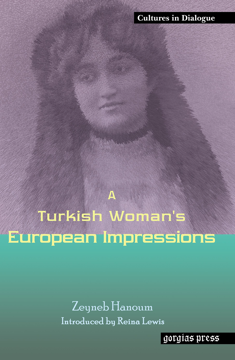Memoirs of Halide Edib
Series: Cultures in Dialogue: First Series 4
ISBN: 1-59333-305-6
A prominent novelist, social activist, journalist, and nationalist, Halide Edib Adivar (1882-1964) was one of Turkey's leading feminists in the Young Turk and early Republican period. Memoirs is the first book in her two volume English-language autobiography, published in 1926, while she and her second husband Dr. Adnan were in exile in London and Paris having fallen out of favor with Mustafa Kemal's one-party regime. Edib describes her childhood, her confrontation with her first husband's polygyny, her divorce, and her entry into political and literary writing. Edib's account of her private life provides a unique example of a woman's individual and personal struggle for emancipation and gender equality.
$165.00 (USD) $99.00 (USD)
In the Palaces of the Sultan (Paperback)
New Introduction by Teresa Heffernan
Series: Cultures in Dialogue: First Series 9
ISBN: 1-59333-303-X
As Anna Bowman Dodd (1855-1929), a New York travel writer and journalist, journeyed to Istanbul with the American Ambassador to France she embarked on a detailed account of the city and its people. Interested in documenting the changes in Turkey brought about by the "embrace" of modernity and progress, she considers Turkish women's rights, harems and marriage, the management of the household, education, slavery, the Sultan's reign, and nationalist movements in the last days of the Ottoman Empire. She caters to the American market for Orientalism but is also reflexive about its employment, both invoking and undercutting stereotypes as she addresses the "Eastern Question."
$166.00 (USD) $99.60 (USD)
A Turkish Woman's European Impressions
New Introduction by Reina Lewis
By Zeyneb Hanoum; Introduction by Reina Lewis
Series: Cultures in Dialogue: First Series 3
ISBN: 1-59333-306-4
Born into the Ottoman Muslim elite, Zeyneb Hanoum and her sister Melek Hanoum were given a Western-style education by their progressive father, who expected them subsequently to live the segregated lives of Ottoman ladies. Rebelling, the sisters collaborated with the French author Pierre Loti, hoping that harnessing European intellectual support would speed up Ottoman social reform. Fleeing Istanbul in 1906 for fear of imperial reprisals, the sisters traveled in disguise to Europe, hoping to find "freedom" in the West. With Zeyneb Hanum's letters punctuated by Grace Ellison's introduction, commentary, and footnotes, this book challenges Orientalist stereotypes and documents the vibrant engagement between Eastern and Western women at the fin de siècle.
$103.00 (USD) $61.80 (USD)
Sunshine and Storm in the East, or Cruises to Cyprus and Constantinople (Paperback)
Series: Cultures in Dialogue: First Series 7
ISBN: 1-59333-304-8
In this diary recording two voyages to Constantinople, Lady Annie Brassey demonstrates her keen eye for human interest and narrative detail. The modern reader will glimpse natural wonders and cultural distinctions of Portuagal, Spain, Moroco, Italy, Greece, and Turkey during the mid-1870s.
$161.00 (USD) $96.60 (USD)
Some Pages from the Life of Turkish Women (Paperback)
New Introduction by Yiorgos Kalogeras
Series: Cultures in Dialogue: First Series 2
ISBN: 1-59333-308-0
Born as a Greek Ottoman in Istanbul, Demetra Vaka Brown (1877-1946) moved to America where she became a journalist and novelist, revisiting Turkey to write several books about the twilight of the Ottoman Empire and the emergence of the Turkish Republic. She based this, her first book, on experiences from 1901, when modernization had made inroads into Ottoman domestic life and the harem was becoming a thing of the past. Her reflections on life in the harem suggest the conflicted nature of her allegiances: Vaka is nostalgic for the Ottoman life that was rapidly disappearing, but she also enjoys the freedoms of a professional American woman.
$106.00 (USD) $63.60 (USD)
The Story of a Turkish Woman's Life (Paperback)
Series: Cultures in Dialogue: First Series 8
ISBN: 1-59333-307-2
Hester Donaldson Jenkins (1869-1941), a professor at the American College for Girls in Constantinople from 1900-1909, wrote enthusiastically about the Young Turks who seemed to promise new freedoms for Ottoman women. Jenkins uses her own observations of Constantinople, her students, and their families to construct an account of a "typical" Turkish Muslim woman's life cycle at this turning point in Ottoman history. She directs her comments toward childhood, education, marriage, polygamy, and divorce, in order to correct Western misapprehensions. In its confidence in the bright prospects of American influence and Ottoman reform, this book captures an optimistic moment in which social progress seemed to be thriving.
$94.00 (USD) $56.40 (USD)
Antioch and Canterbury (Limited Edition)
The Syrian Orthodox Church and the Church of England (1874-1928)
ISBN: 1-59333-235-1
This study helps to provide an understanding of the Syrian Orthodox Church, in the more recent past. In particular, it seeks to relate how that Church experienced contact with the Church of England.
$293.00 (USD) $175.80 (USD)
The World of the Maya
ISBN: 1-59333-274-2
Sam Osmanagich transports the reader to ruined Mayan cities including the brilliant Chichen Itza, elegant Uxmal, artistic Copan, magical Palenque, forgotten Ek Balam, beautiful Izamal, hidden Yaxchilan, spiritual Oxkintok, monumental Coba, and colossal Tikal.
$95.00 (USD) $57.00 (USD)
Prolegomena to a Grammar of the Hebrew Language
ISBN: 1-59333-334-X
Translated for the first time, with annotations and useful additions, this long under-appreciated work of S. D. Luzzatto is now available to modern scholars. A history of both Hebrew and Hebrew scholarship, it is replete with valuable information and insight.
$148.00 (USD) $88.80 (USD)
Authority within the Christian Church
By Peter Lee
ISBN: 1-59333-342-0
At the present time, when authority for the church's beliefs and actions is the subject of much discussion, this book attempts to look to the authority of God, Jesus Christ, and the Holy Spirit, and how these are transmitted within apostolic tradition by word, actions, and writings. Elements giving weight to authority (co-inherence, consistency, and universality) are examined along with the scope and limits of interpretative tradition.
$142.00 (USD) $85.20 (USD)









